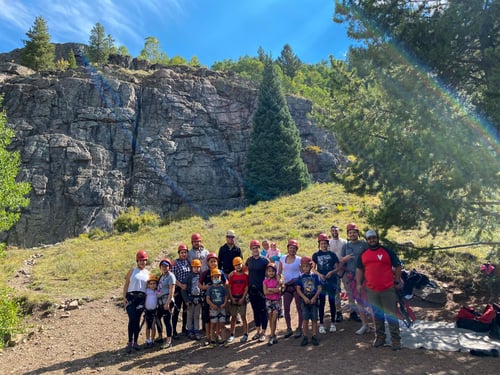Throughout humankind’s long history of manipulating the landscape, one universal truth persists—rivers flow. And as they flow, they shape the land. It’s a reciprocal agreement, where the river constantly carves and deposits, and the land’s shifting arrangement of sediment and nutrients feeds diverse life. The Eagle River, which carved much of our valley, is no different—except where it enters Camp Hale. During World War II, the Eagle River’s winding path was converted into a straight shot to winning the war. Today, we have an opportunity to restore it.
Officially, the Eagle River begins where the East Fork and the South Fork come together, just below the Continental Divide. Initially, it meanders and shapes the land naturally. Its kinetic energy erodes the riverbanks, eventually depositing the eroded particles to create sandbars and bends. Rivers mix new soil, piling up nutrient-rich sediments that support a diverse ecosystem. In these bends and wetlands, the languorous water protects vulnerable young fish, amphibians, insects, and birds. Life downstream benefits from the water filtering, flood control, and wildlife habitat that such riparian systems provide.

A popular Camp Hale activity: rock climbing.
The Eagle River’s natural character changes significantly where it enters the Pando Valley, now known as the Camp Hale – Continental Divide National Monument. It goes from a typical mountain stream, meandering and eroding its way across the landscape, to an artificially straight, man-made channel. While the famous 10th Mountain Division training ground at Camp Hale was considered instrumental in winning the war, it spelled anything but victory for the local ecology. To build Camp Hale in 1942, the river’s rich meadows and lush wetlands were drained and replaced with millions of tons of imported fill, and the river’s path was engineered into a manmade ditch. The once-diverse, sprawling wetland became a skeleton of its former self, faster, steeper, and nearly 40% shorter. As the Eagle River hurries through the valley in its confined path, it becomes devoid of the nutrients and ecological overflow that would move downstream were it a wetland. Aquatic plants and animals are washed away in the strong current or suffocated by the sediment-choked waters. The land can no longer absorb stormwaters and snowmelt, increasing the odds that the river will spill over its banks in places where floods rarely happened before. In the war’s aftermath, it’s clear that the Eagle River is collateral damage that needs to be remedied.
The river has its advocates. In 2015, a group of local stakeholders created a Master Plan for the restoration of Camp Hale. The plan included an extensive rejuvenation of the Eagle River, with efforts to restore it to a natural state with meanders, wetlands, and native vegetation. Unfortunately, this ambitious effort is also expensive, and while the promotion of Camp Hale to a National Monument gives the site access to federal funds, it also puts it on a long list of other projects waiting for room in the budget. As the valley’s management plan is developed, the monetary costs of restoration must be weighed against the very real ecological costs of an unhealthy river.
The war is over, and fortunately, we won. Now, as Camp Hale celebrates one year as a National Monument, it’s time to reward the river for its contribution to the war effort. The time when there was a plausible call to straighten this river has passed; the Eagle River deserves to run freely across the landscape. And the landscape, and all of us who live downstream, deserve to have our river back.
This article was written by Jaymee Squires, the current Director of Graduate Programs and the Senior Faculty Adviser at Walking Mountains Science Center in Avon, CO.







